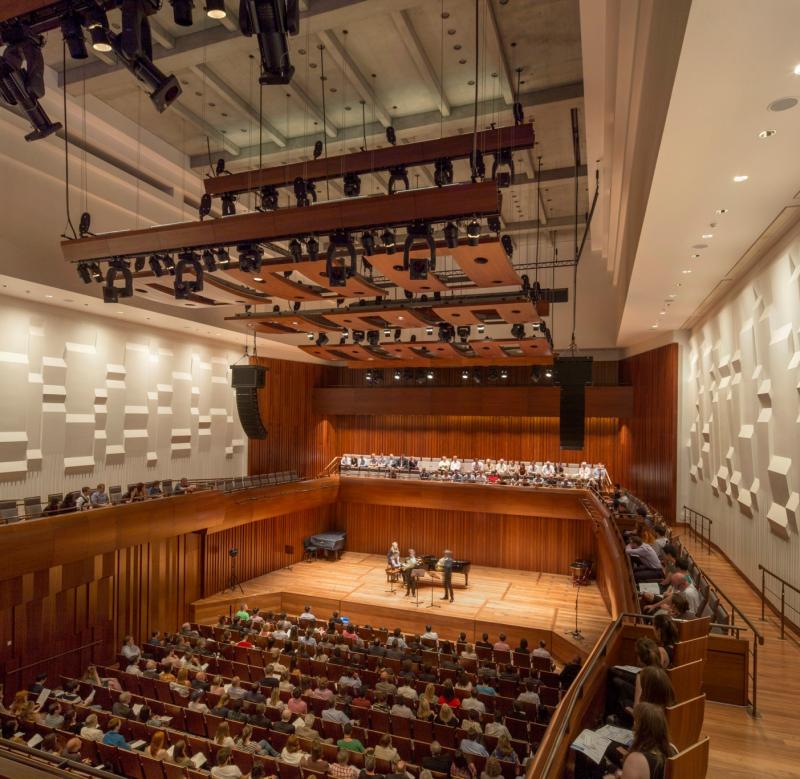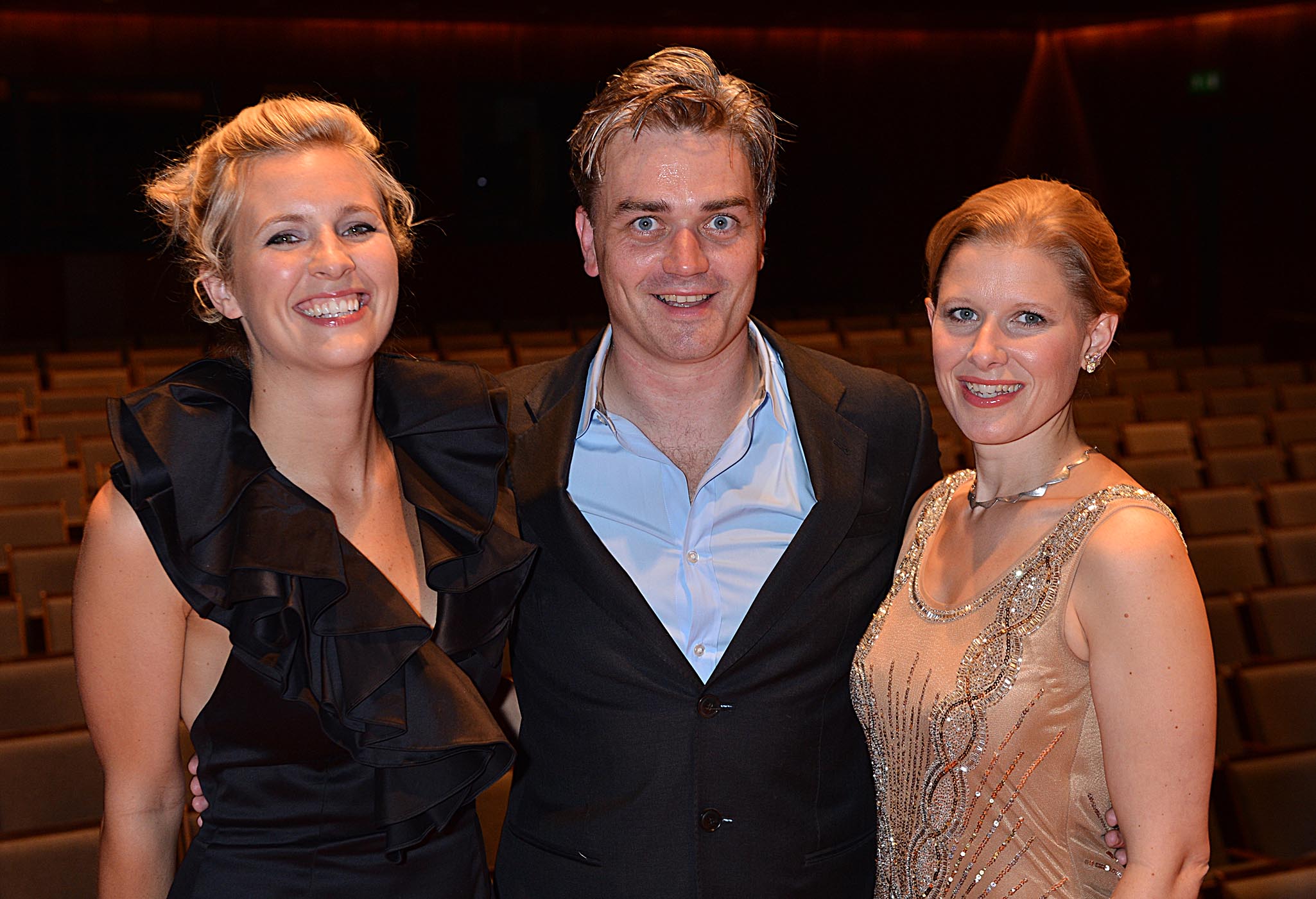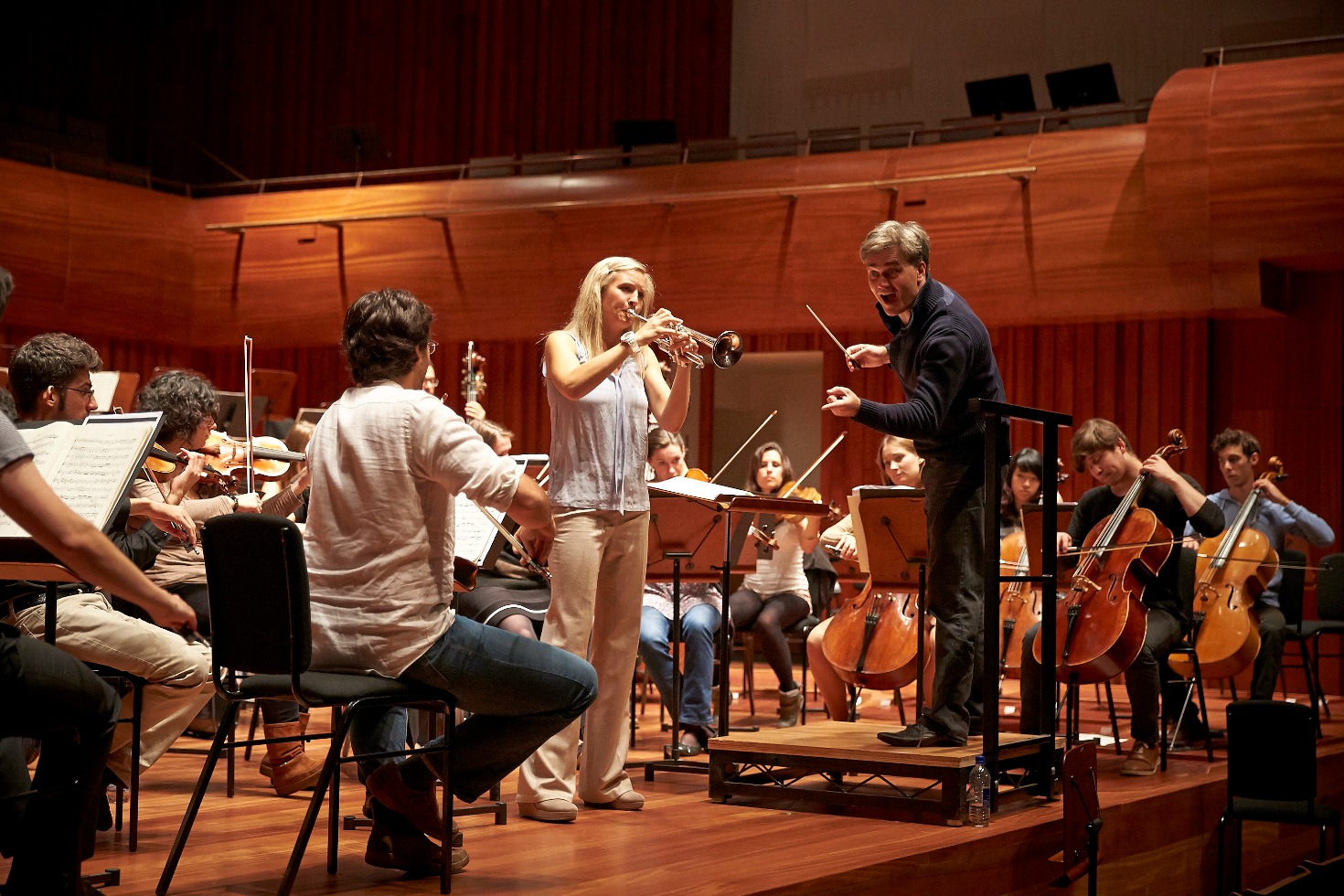Milton Court Opening, GSMD | reviews, news & interviews
Milton Court Opening, GSMD
Milton Court Opening, GSMD
Large forces overwhelm a modest new hall, but Guildhall students and graduates dazzle

Night life in the Square Mile, at least from the perspective of my evening routes around the Barbican, is dominated by booze and sportiness. The way to last Thursday’s concert was blocked by a Bloomberg relay marathon, and cycling through the tunnel towards Milton Court yesterday evening, I encountered the bizarre spectacle of carnival-style trucks pedalled by a dozen drinkers apiece, sitting at a central "bar" and already well oiled.
The City of London’s partnership with Heron International means that there’s a money-making, 36-storey residential tower attached. In David Walker Architects’ squeezed-in design, the complex's white concrete façade is rather dwarfed by "The Heron" with its tower of black glass. There should be plenty of natural light in the rather low-ceilinged foyers, but this is the City, and buildings hem Milton Court in on every side.
Last night’s main event was to inaugurate the 608-seater Concert Hall. Odd in these straitened times to think of it with Kings Place’s Hall One down the road, which opened only five years ago, though it's great to have both. Acousticians of choice Arup worked on the two halls, so it’s curious that the smaller venue in Kings Place (420 seats) sounds as well as feels more spacious (and its single-oak panelling is still more handsome than Milton Court's sapele timber). But then perhaps a full antiphonal brass ensemble, organ and percussion to start and a capacity late-romantic orchestra to conclude were not the best choices for the Milton Court centrepiece: it’s rather like getting the full London Sinfonietta to grace the Wigmore. The GSMD Orchestra will indeed be giving concerts here, but the majority of events will be for chamber forces or voice and piano, and those were what I look forward to testing more keenly.

We had two of the brightest and most glamorous of ex-Guildhall stars, great singers both: trumpeter Alison Balsom, who may well become a Dame before ex Gardner gets his knighthood, and soprano Sally Matthews (both pictured above with Gardner by Mark Allan). It was clear that even her limpid tones would come over rather forcefully, and the slightly backward placement always takes some getting used to before you can be overwhelmed by the sheer musicianship; but overwhelmed I was by those grave chromatic descents in Mozart’s stunningly inventive concert aria “Bella mia fiamma…Resta, o cara”. Superb orchestral support, too, though even with a smallish ensemble the woodwind details weren’t clear in this acoustic.
Balsom (pictured above in rehearsal with Gardner by Clive Totman) caressed her singing phrases, just like the GSMD strings, right from the start in Haydn’s Trumpet Concerto, and if the perfect handling of a trill is the mark of a great artist – I reckon it is – then she’s up there with pianists Mitsuko Uchida, Imogen Cooper and Christian Ihle Hadland. The cadenza at last gave us the chance to measure the truthful tone-capturing of a single instrument in the hall, and the effect was one of pure brilliance. Elgar’s Cockaigne threatened to bring the house crashing, but Gardner got round that by encouraging sheer suppleness of articulation from his rumbustious forces: the late romantic rubato and tenderness to the life. If the last performance of this work I heard – from the BBC Symphony Orchestra at the Barbican under the most inept conductor they’ve ever worked with - had been the slowest and the worst, this was the best: no allowances needed for youth or inexperience.
That was by no means the end of the evening: there were speeches and then the chance to explore all of Milton Court’s venues – including the 223-seater Theatre and flexible, max 128-seater Studio Theatre as well as rehearsal and teaching rooms – with students in active residence.
 I’ll return to see them all, but I’d set myself a challenge after the concert: to pedal like fury to the Wigmore Hall where Anne Schwanewilms (pictured left) had stepped in for an indisposed Angelika Kirchschlager and – in addition to Debussy, Mahler and Strauss songs, most of which I’d fortunately heard her sing there before, since I had to miss them this time – was performing the Wesendonck Lieder, surely bicentenary year's most performed Wagner work, with the infinitely sensitive Charles Spencer.
I’ll return to see them all, but I’d set myself a challenge after the concert: to pedal like fury to the Wigmore Hall where Anne Schwanewilms (pictured left) had stepped in for an indisposed Angelika Kirchschlager and – in addition to Debussy, Mahler and Strauss songs, most of which I’d fortunately heard her sing there before, since I had to miss them this time – was performing the Wesendonck Lieder, surely bicentenary year's most performed Wagner work, with the infinitely sensitive Charles Spencer.
I got there in time for that crowning glory, and its uniquely centred, hypnotically drawing-in interpretation made me glad I had. Schwanewilms adapts her exquisite colours to the texts, which is why only the fourth song brought forth the usual Wagnerian opulence – and how. Sorry I didn’t get the full Milton Court experience? How could I be, under the circumstances. This is London, and you have to grasp the nettle when and how you can.
- Programme of events at Milton Court here
- Anne Schwanewilms' new recital disc discussed on David Nice's blog
rating
Share this article
Subscribe to theartsdesk.com
Thank you for continuing to read our work on theartsdesk.com. For unlimited access to every article in its entirety, including our archive of more than 15,000 pieces, we're asking for £5 per month or £40 per year. We feel it's a very good deal, and hope you do too.
To take a subscription now simply click here.
And if you're looking for that extra gift for a friend or family member, why not treat them to a theartsdesk.com gift subscription?
more Classical music
 theartsdesk Q&A: conductor Dalia Stasevska on her new album of contemporary orchestral music
Finnish-Ukrainian conductor looks to bring the music of today to new audiences
theartsdesk Q&A: conductor Dalia Stasevska on her new album of contemporary orchestral music
Finnish-Ukrainian conductor looks to bring the music of today to new audiences
 Classical CDs: Beans, carrots and bassoons
Danish pianism, a great conductor's Italian recordings and a bold contemporary compilation
Classical CDs: Beans, carrots and bassoons
Danish pianism, a great conductor's Italian recordings and a bold contemporary compilation
 Prom 50, Fujita, Czech Philharmonic, Hrůša review - revelations where least expected
Fresh-faced, unpredictable Dvořák, majestic if not entirely visceral Janáček
Prom 50, Fujita, Czech Philharmonic, Hrůša review - revelations where least expected
Fresh-faced, unpredictable Dvořák, majestic if not entirely visceral Janáček
 Prom 49, Kobekina, Czech Philharmonic, Hrůša review - what an orchestra
Glorious playing save for a disappointing cellist
Prom 49, Kobekina, Czech Philharmonic, Hrůša review - what an orchestra
Glorious playing save for a disappointing cellist
 Verdi's Requiem / Capriccio, Edinburgh International Festival 2024 review - words, music, judgement
Philharmonia Orchestra closes the festival with grandeur and intimacy
Verdi's Requiem / Capriccio, Edinburgh International Festival 2024 review - words, music, judgement
Philharmonia Orchestra closes the festival with grandeur and intimacy
 theartsdesk in Switzerland: Lucerne and Gstaad offer curious audiences fresh perspectives on much-loved works
Two summer festivals find ever new ways to make each concert a memorable event
theartsdesk in Switzerland: Lucerne and Gstaad offer curious audiences fresh perspectives on much-loved works
Two summer festivals find ever new ways to make each concert a memorable event
 Fire in my mouth, Philharmonia, NYCOS, Alsop, Edinburgh International Festival 2024 review - total work of art for our times
A powerful portrayal of hope-filled journeys and bright futures extinguished
Fire in my mouth, Philharmonia, NYCOS, Alsop, Edinburgh International Festival 2024 review - total work of art for our times
A powerful portrayal of hope-filled journeys and bright futures extinguished
 Prom 44, Shani, Rotterdam Philharmonic review - impressive multi-tasking by conductor-pianist
Prokofiev’s Third Piano Concerto turned into a giant piece of chamber music
Prom 44, Shani, Rotterdam Philharmonic review - impressive multi-tasking by conductor-pianist
Prokofiev’s Third Piano Concerto turned into a giant piece of chamber music
 Prom 42, Beethoven's Ninth Symphony, Aurora Orchestra, Collon review - a dramatic coup
The intrepid players' 'most challenging' from-memory concert
Prom 42, Beethoven's Ninth Symphony, Aurora Orchestra, Collon review - a dramatic coup
The intrepid players' 'most challenging' from-memory concert
 Prom 37, War Requiem, Clayton, Liverman, Romaniw, LSO, Pappano review - terror and tenderness
Full human drama in Britten's admonitory masterpiece
Prom 37, War Requiem, Clayton, Liverman, Romaniw, LSO, Pappano review - terror and tenderness
Full human drama in Britten's admonitory masterpiece
 Altstaedt, EUYO, Noseda, Edinburgh International Festival 2024 review - inclusive and brilliant
If these young musicians are the future, then the future looks bright
Altstaedt, EUYO, Noseda, Edinburgh International Festival 2024 review - inclusive and brilliant
If these young musicians are the future, then the future looks bright


Add comment